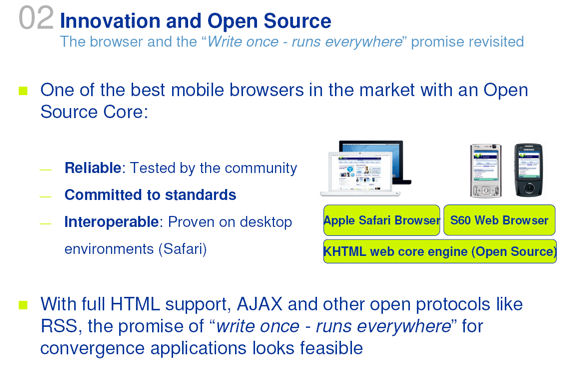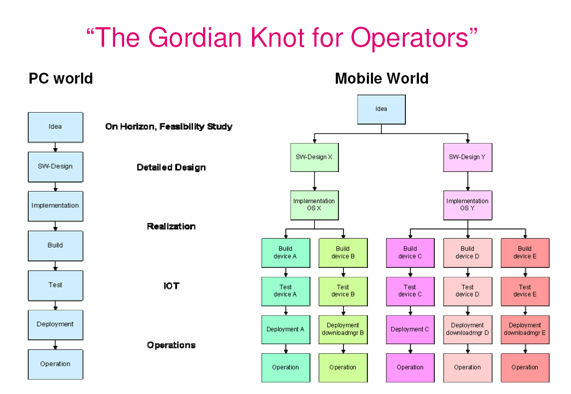Telefonica and T-Mobile provided two of the keynotes at the recent S60 Summit which reflects both the continued dominance of operators within the mobile ecosystem, but also the growing operator momentum behind the S60 platform. Both speakers talked about the importance of software platforms for next generation terminals, but offered different perspectives. Here I summarise the main points made by each of the speakers.
The S60 Advantage for Operators: Innovation and Value Creation (Telefonica)
Jose Moujadami from Telefonica spoke about how the changing mobile ecosystem, the move towards 'openness' and S60 could be used to increase revenue in mature markets by allowing innovation in products and services that met the demand for openness.
The first half of the keynote focused on the changes in the ecosystem being driven by a stronger consumer preference which are leading to greater 'openness'. Openness is a general term for the idea that traditional barriers and ways of doing business are breaking down due to market evolution and as the consumer demands more choice. This openness extends across the entire ecosystem: phones are becoming open (e.g. software platform such as S60), service provision is become open (e.g. the rise of Web 2.0 and the move to mobile); content generation is becoming open (e.g. user generated content).
One well developed example of this is in operator services, where, in the last few years, the industry has moved away from the walled garden approach in favour of a more open approach. This is partly in response to consumer demand (they want open access to the Internet), but also because operators have come to realise they cannot do everything. The provision of additional products and services is key because Telefonica recognises that there is great growth potential in this area, and as traditional revenue sources (voice, SMS) begin to stagnate or shrink it is here than it will look to continue to grow.
Operators such as Telefonica are looking for partners to work with which further reflect the move towards an open ecosystem. With the idea of openness becoming established, operators and other members of the mobile ecosystem have found themselves in a different competitive landscape than that which they are used to. Operators therefore must look at new ways of creating value, Moujadami argued that this can be achieved through delighting the customer with the best care and services, effectively using customer knowledge (operators still own the customer) and by giving the best experience through technology. All of these innovations need enablers and it is here that the software platform will be playing its part.
Software on mobile phones is no exception to 'trend' towards openness and the S60 platform is at the vanguard. Moujadami particularly highlighted the platform advantage, together with the provision of APIs which have reduced development costs and time to market as key generic enablers for creating new value. It is clear that Telefonica considers the software platform as a key enabler for 'openness' discussed above. Thus in the second half of his keynote he described some of the ways S60 is helping Telefonica address the new openness driven market.

Slide from Moujadami highlighting the importance of the Browser
Moujadami highlighted the importance of the browser as an enabler noting that it was particularly attractive because it was based on open standards, was reliable and looks best placed to fulfill the promise of 'write once - run everywhere'. The S60 Web browser is especially attractive because it is based on the open source Web Core which is a proven technology on the desktop. The inter-operability of the Web browser is very attractive to operators because as we see the convergence of service distribution (the idea that we will consume the same content through the TV, Web, and Mobile) it becomes even more important than before.
Open C was also highlighted as an attractive technology because it allowed relevant applications to be more easily ported to the mobile environment. Similarly, the provision of Python and Perl runtimes are important because they increase developer accessibility and choice. All of these allow for easier innovation, which is the key to creating new value and increasing competitiveness. Moreover they also reduce the differences between connected PCs and mobile phones, which is key for converging applications.
Finally, Moujadami talked about the flexibility S60 provides to operators in creating branded versions. The ability to create a branded look and feel helps increase commitment to the operator brand, creates a consistent user experience and simplifies the access and promotion of new services and applications. Furthermore, S60 provides device management tools which allow remote updating of branding application and services.
S60 as the next generation terminal platform: moving to the mid-tier (T-Mobile)
Karman Kordi from T-Mobile discussed S60 as the next generation terminal platform and the importance of the mid tier market. He said that the platform approach is 'a key step to address the challenges facing operators'. These challenges are a market of ever increasing complexity with multiple players. The mobile ecosystem is fragmented because it's made up of multiple platforms (mostly proprietary) used by many manufacturers, each with many different devices. Each one of these devices requires its own integration and testing program which represents a very significant cost. Kordi referred to these challenges as the Gordian knot for Operators. Previously this issue has not been a major problem, but as mobile devices become increasingly complex and become more PC like the level of integration and testing required has increased, with consequently higher costs.

Slide from Kordi illustrating the current complexity of the market in terms of devices
The software platform looks to solve this problem by introducing a greater amount of standardisation. This standardisation can be rolled out across multiple vendors and allows for a greater penetration and roll out of consistent quality services from the operator. Moreover, using a software platform brings other advantages such as the ability to try out services without having custom devices built, the ability to differentiate between operators without impacting a manufacturer's production process (keeping costs low), and increases the manageability of the devices for operators through device management and easier device customisation. At the heart of all of these is the ability to reduce costs and speed the time to market.
S60 is one software platform that can potentially solve the Gordian knot because it provides standardisation but also allows customisation. Kordi said that S60 was particularly attractive because of its broad scope. The support for multiple chipsets with the software effectively acting as an abstraction layer as far as the operator is concerned is one example of this. S60 has the ability to support multiple families of products running on different hardware.
However, Kordi was keen to stress that there was still room for considerable improvement. He argued that there was a need to lower hardware costs to more strongly address the mid tier to ensure long term success, as this is where T-Mobile sees the most potential for software platforms. It must also continue to improve key performance indicators and increase the modularity of the platform. Kordi said that in some cases operators may want to replace a given component (e.g. the browser) within the software platform and the modularity should be in place that enables them to easily do this (although, of course, others would argue that Nokia should defend against this to an extent to maintain platform uniformity).
Orange and S60
S60 is also working with other operators. I had a chance to learn more about this at a recent Orange Partner Camp Event. The Orange Container Program, announced last year, is Orange's strategy for creating devices than fulfil the Orange ethos while minimising the time to market. It is a standard Orange software layer that sits on top of S60. It consists of icons, applications, wallpapers, homescreens, menu structure customisation and more. Minimising time to market is very important; internal research at Orange has shown devices sell best when they are 'young', delays due to customisation (the time taken is generally related to complexity of the phone) can significantly impact sales. By creating a standard layer built on top of a software platform the time and cost needed to customise (create a Signature device) is greatly reduced.
The Container Program marks a move (for Orange Signature devices) from an Orange player, to an Orange layer (that it to say the customisation of a phone becomes standardised on a platform rather than on a phone by phone basis). Incidentally Orange is also planning to use other platforms as part of the Container program, there will be Signature for S60, Signature for Windows Mobile, and Signature for ALP. The software layer is the heart of the Orange Container Program.
Practically the Container Program will create a commercial and technical single point of contact for device manufactures and developers. It will combine UI customisation, iconography, menu structure, colour scheme, wallpapers, ringtones, applications, and home screens into a single package. This will be made available as a product (on a CD) to manufacturers who can integrate it into their device development process. This is very similar to the Vodafone software layer that has been developer by S60 and Vodafone and used in the Samsung i520.
Note: This information in this section comes from a discussion with Yves Martin at the recent Orange Partner Camp.
Operator Thoughts - S60 gains momentum
Both operator speakers clearly see software platforms as the future for next generation terminals. Each described a different justification, although ultimately they were both about creating an ability to innovate (creating value) while keeping costs and time to market low.
Kordi spoke about the advantages of having a modular platform which enables the replacement of standard components with custom components. There is merit to this, but also there is a danger that the platform can become fragmented, which is to the detriment of all. A more compelling justification for modularisation is the ability to create handsets better tailored to individual niches, but also create handsets that have lower hardware requirements and therefore lower costs (bill of materials). There is, naturally, a compromise between flexibility (modularisation) and platform homogeneity (unity) which is a delicate balance.
Moujadami offered a compelling vision of Operator 2.0, which attempts to answer how operators survive as the market becomes more open. His solution was an operator that embraces openness and seeks to create value by using the software platform to create innovation and customer delight. Kordi, by contrast, offered a more economic-focussed argument explaining that increasing complexity in the make up of terminals and the mobile ecosystem had created a Gordian knot. The solution is to use software platforms to cut costs by embracing standardisation, effectively commoditizing hardware and placing the value in the software layer.
In effect these are parts of the same argument. Software platforms should allow the current market state to be achieved at a lower costs and also allow for the creation of new value in the future. S60 looks to be in a very good position to capitalise on this potential. At a love-in like the S60 Summit it's easy to get carried away with the potential and there are a variety of obstacles and barriers to overcome, but even so there is real evidence of the momentum of S60. There are operators working with S60: Vodafone, T-Mobile, Orange and Telefonica are among the most high profile, but S60 say there are also those who have not made official announcements. Of course, S60 still has competitors, but significantly, and in contrast to other software platforms, it has now reached the stage where multiple operators are talking about how they are integrating it into their roadmaps, which directions they would like it to go and what they want to achieve with it. It seems it is not a question of whether it will become a significant force in the future but rather how significant a force it will become.
Rafe Blandford, AllAboutSymbian, 1 May 2007
